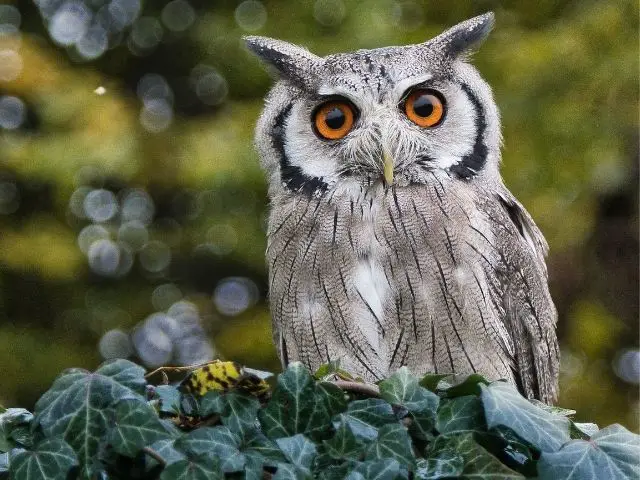You will come across several pictures of owls in Arizona when surfing on the internet.
But of course...
It is not the same as looking at the real deal but be sure to bury those images through your skull.
You’ll need them for your trip (for Arizona owl identification) - if you’re planning one.
The pictorial presentation of owls native to Arizona will give you a better understanding of where they differ from each other by looks. However, there is much more than the vibrant colors and size that make each of the owls in the Arizona desert unique.
Most Commonly Sighted Owls In Arizona
Here are some of the most popular among the owls that live in Arizona and detailed insights into what makes them unique:
1. Great Horned Owls

The Great Horned Owls are probably the largest birds that reside in Arizona all year round. They can also be abundantly seen in North America. They are fierce predators and can even take down any larger prey; these owls often prey on other birds of their own size.
You can easily identify these owls due to their larger size, ear tufts, and furrowed brows.
Size & Weight Specifications
The great horned owls are generally 18.1 to 24.8 inches long.
They weigh about 32.1 to 88.2 oz. and have a wingspan of 39.8 to 57.1 inches.
Spotting Them
The great horned owls are normally seen in the swamps, deserts, or forests. However, you can also find them in urban areas, including suburbs, in the cities or parks. They are larger in size as compared to a red-tailed hawk.
The great horned owls are nocturnal, you can see them in the dusk, sitting on a height.
2. Northern Saw-whet Owls
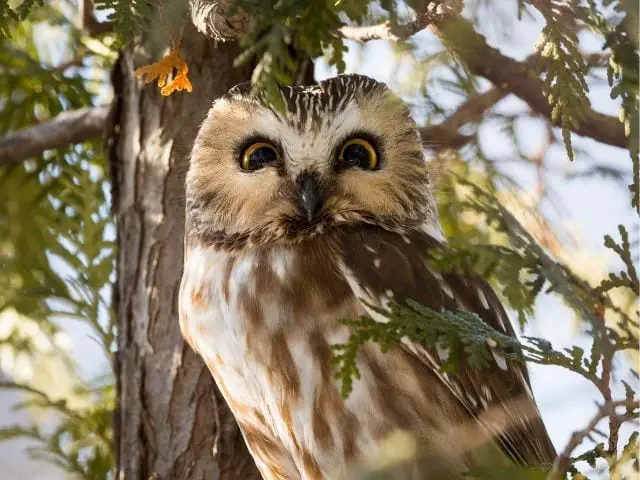
The northern saw-whet owl is slightly smaller and can be seen all year round in most of Arizona. These owls have a non-breeding status in the southwest of the states. It has distinctive cat-like eyes that are yellowish in color with comparatively smaller sizes.
Size & Weight Specifications
The northern saw-whet owl is about 7.1 to 8.3 inches long with a bodyweight that falls between 2.3 to 5.3 oz. It has a wingspan between 16.5 to 18.9 inches.
Spotting Them
If you wish to see them, focus on their voices in the forest. They prefer going out on quiet nights in the January-May period. You will often hear them making “too-too” sounds. The northern saw-whet owl roosts silently in trees and is usually difficult to spot.
3. Barn Owls
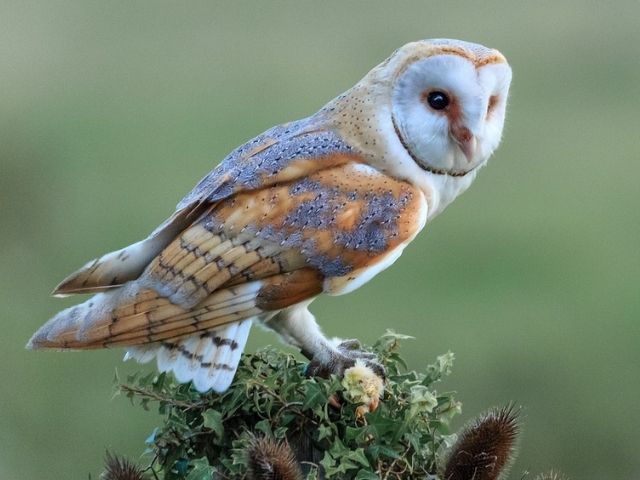
Barn owls reside in Arizona throughout the year. They are beautiful birds with white heart-shaped faces. They are called so because of their unique nesting style, similar to barn structures and abandoned buildings.
They can swallow their prey whole, with bone and feathers (if any). However, later on, they regurgitate all the unnecessary parts. These owls have an amazingly strong low-light vision, however, hunting and tracking are solely based on sound.
Size Specifications
Barn owls are about 12.6 to 15.8 inches long with a bodyweight that falls between 14.1 and 24.7 oz. They have a wingspan between 39.4 to 49.2 inches.
Spotting Them
If you wish to see them, listen to the screeches in the night or look for flashes of pale white wings. However, they are generally known for being obscure. Hence it is much harder to see barn owls as compare to others on the list.
4. Northern Pygmy Owls
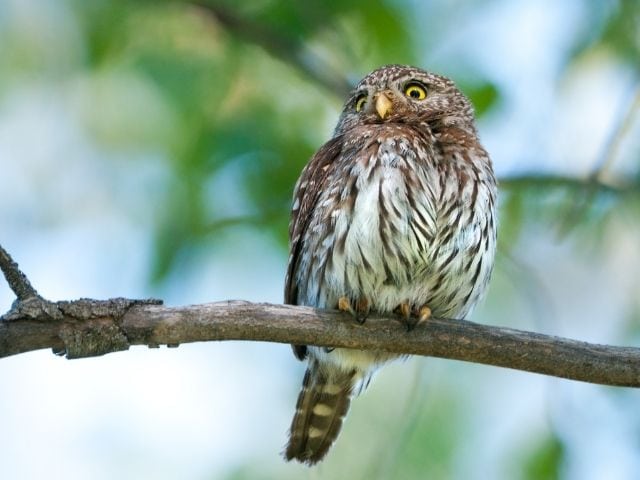
The northern pygmy owls are common in eastern and northern Arizona. They are smaller in size in comparison to other types of owls in Arizona and mainly feed on the songbirds. Unlike other owls, the northern pygmy owls are not inclined towards man-made nests.
Their distinctive features include yellow eyes and beaks, they also have white speckles on the top of their head.
Size Specifications
The northern pygmy owls are about 6.3 to 7.1 inches long with an average weight between 2.1 and 2.5 oz. They have a wingspan between 14.5 and 16 inches.
Spotting Them
These owls are circadian; in other words, they are active during the day. Hence you have a better chance of spotting them in daylight hours. However, they will sit quiet and calm during the day as it helps them surprise their prey, so keep your eyes peeled.
5. Western Screech Owls
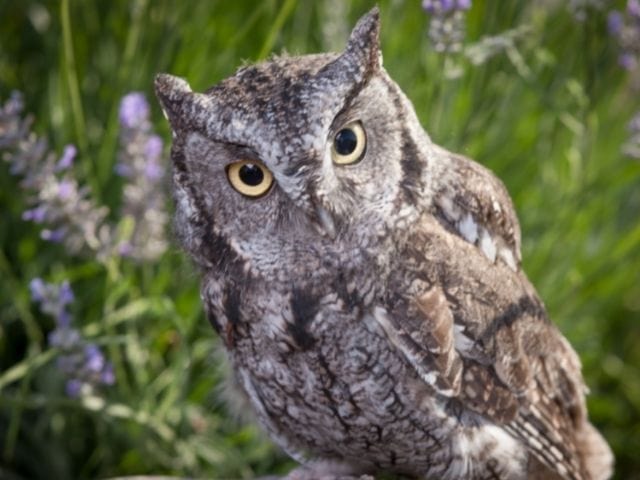
The western screech owls nest in the tree cavities but will also come to the nesting boxes, if available. These owls are small in size, yet they are amazing hunters who can take down prey as bigger as a rabbit.
For the same reason, they are a bit difficult to spot.
Size Specifications
The western screech owls are about 7.5 to 9.8 inches long, with an average body weight between 3.5 to 10.8 oz. The average wingspan is between 21.6 to 24.4 inches.
Spotting Them
The western screech owls can easily be seen in the open woodlands. Likewise, you can also spot them in urban areas with trees or parks across entire Arizona. Unlike their eastern cousins, the western screech-owls make “toot-toot” sounds.
6. Mexican Spotted Owls
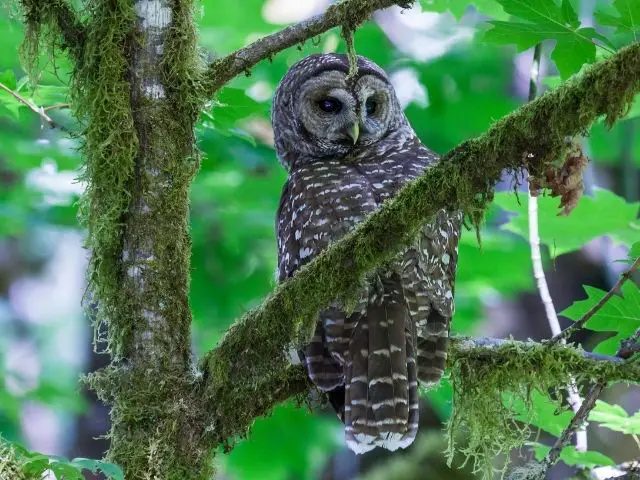
Mexican spotted owls are among the three species of spotted owls and the largest in North America. These owls are marked as endangered by both Mexican and US governments. You can find them in small groups in Arizona, New Mexico, Colorado, Utah, Nevada, and Texas.
By now, they have an average breeding population of about 15,000 owls – around the globe. A half is residing in the USA from this total population, with about 40% in Mexico.
The barred owls are another major reason for the declining population of Mexican spotted owls.
Size Specifications
Mexican spotted owls are about 16 to 19 inches long with an average body weight of 19.5 to 23 oz. They have a wingspan between 42 to 45 inches.
7. Ferruginous Pygmy Owls

Ferruginous pygmy owls are usually seen in the South-East of Arizona and Texas. They are also considered endangered species of owls in AZ. However, they are still spreading in South and Central America.
However, you can still spot them in the deserts rich with saguaro cacti and mesquite forests alongside rivers.
Size Specifications
Ferruginous pygmy owls are about 6.5 to 7 inches long with a weight between 2.2 and 2.7 oz. They have a wingspan of 14.5 to 16 inches.
Spotting Them
They are usually active during the day, so be sure to search for them in the daylight hours.
They like to feed on songbirds, small mammals, insects, and lizards.
Fun Fact: Did you know that one of the more popular songbirds in the United States is the Song Sparrow in Vermont?
Tips For Attracting Arizona Owls To Your Yard
Although owls are not on the list of common backyard birds. They can be highly desirable guests. It is amazing to hear their unique calls closely or to see them in the night.
No matter if you wish to see the white owls in Arizona or want to host some Sonoran Desert owls, the following approaches can surely come in handy:
Nesting Boxes
The most effective way is to install nesting boxes in a secure corner of your garden. Remember, owls look for hollow cavities and quieter places to nest in. With the right placement of nesting boxes, you can attract species like screeching owls.
But make sure the box is placed about 10 to 12 feet above the ground.
Timers On Outdoor Lights
Owls like darker places, so try to place a timer on the outdoor floodlights.
You can also turn off the lights before going to bed and allow a secure environment for owls to visit you.
Birdbaths

These never fail to attract birds, even the owls, especially during the cruel summers but also in the winters.
Owls are attracted to larger birdbaths for bathing or drinking.
Larger Branches On Trees
If you wish to attract owls, avoid pruning larger tree branches; remember that horizontal perches serve as prime locations for owls to perch.
Frequently Asked Questions Section
Here are responses to some of the most common questions in this regard:
What kinds of owls live in Arizona?
There are 13 different species of AZ owls:
- Whiskered Screech Owl
- Northern Pygmy-Owl
- Elf Owl
- Burrowing Owl
- Mexican Spotted Owl
- Barn Owl
- Short-eared Owl
- Long-eared Owl
- Great Horned Owl
- Northern Saw-Whet Owl
- Western Screech Owl
- Ferruginous Pygmy-Owl
- Flammulated Owl
What do owls eat in Arizona?
The Arizona owls feed on a range of items. Some like to feed on mammals, reptiles, birds, and fishes. At the same time, some particular species of Arizona owl like to feed on snails, insects, spiders, earthworms, and even crustaceans.
The choice of food entirely depends on the habitat they live in and the species they belong to. Many owls also like to eat moths and beetles and larger birds. Moreover, owls can drink, and they usually meet their water needs from the animals they prey on.
In the winter, the owl may fulfill their water needs by eating snow.
Are owls common in Arizona?
Yes, there are more than 13 Arizona owl species that are commonly seen in the region. Among all of the owl species in Arizona, the barn owls are the most commonly occurring species of owls of Arizona and are among the most widespread birds. However, the local population is declining due to the loss of appropriate habitat.
Other factors include the collision with vehicles, pesticides, and so on but you can still find them in abundance in open areas of Arizona.
What is the biggest owl in Arizona?
The horned owl is the largest living owl in Arizona. This owl has an estimated height of 2 feet, it also features a brown/grey color with barred feather patterns on the underside. This owl also has a whitish throat that looks like a collar and distinctive ear tufts and larger yellowish eyes with black prominent pupils.
This owl usually roosts during the day in isolated areas like rocky overhangs or tree limbs.
They have excellent hearing abilities that they use when awake or hunting. In addition, they have amazing eyesight with the ability to fly quietly. A horned owl can easily be seen anywhere in the United States, some regions of Canada, and in Central & South America.
The horned owl is widespread and does not fall under the category of endangered to threatened birds. Horned owls love to eat a variety of food; these include snakes, birds, fish, frogs, rabbits, hares, rodents, and so on.
Are owls protected in Arizona?
Yes, all owl species in Arizona are protected under the Federal Law and Migratory Bird Treaty Act. These birds are also protected under the Arizona State LAW – ARS Title 17. It is illegal to hunt, kill, capture, or cause any sort of damage to any species.
Before we move on, here is a super amazing YouTube video about barn owl cries (you should check out other Arizona owl sounds too):
Closing Thoughts
Some owls are seasonal visitors to the region, while others stay here all year round. However, it would help if you were lucky enough to watch them with the naked eye. But you can do that by visiting their local habitat, including deserts, forests, and higher spots within the city.
I have mentioned the most popular and common owls in Arizona with tricks on welcoming them in your yard. I wish you luck with your owl-watching experience. However, make sure you are not causing them any hurt whatsoever.
And be sure to look at lots of pictures too, just type in “owls in Phoenix” or “owls in Tucson” in Google and browse through the images to acquaint yourself with the native species.
Good luck!

